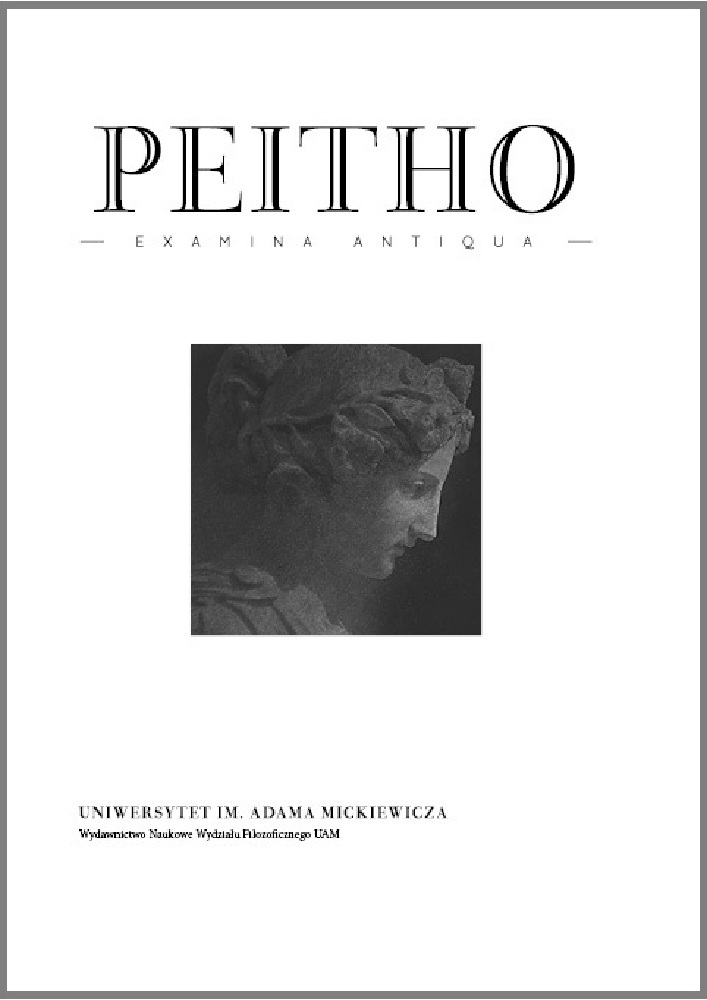Abstract
It is generally accepted that the enigmatic fragment 12 of Parmenides, supplemented by the first part of A.tius II 7.1, represents an unlikely cosmos which comprises alternating spherical crowns of fire and night, surrounding the earth. A comparison of the fragment and A.tius’ text shows that the latter adds nothing substantial to the fragment. Thus, fragment 12 can actually represent the structure of the earth, which consists of a core of fire, is surrounded by the layers of the earth’s crust, into which heat is transmitted from within, and on which the goddess of life dwells.
References
Barnes, J., 1979, “Parmenides and the Eleatic One”, Archiv für Geschichte der Philosophie, 61, pp. 1-21. DOI: https://doi.org/10.1515/agph.1979.61.1.1
Bollack, J., 2006, Parménide, de l’étant au monde, Lagrasse.
Bredlow, L. A., 2010, “Cosmología, cosmogonía y teogonía en el poema de Parménides”, Emerita (EM) 78, pp. 275-297. DOI: https://doi.org/10.3989/emerita.2010.v78.i2.499
Brisson, L., Macé, A., Pradeau, J. F., 2022, Les Élèates, Paris.
Burkert W., 1962, Weisheit un Wissenshaft. Studien zu Pythagoras, Philolaos, und Platon, Nürnberg (english transl. E. L. Minar Jr.: Lore and Science in Ancient Pythagoreanism, Cambridge 1972).
Calenda, G., 2015, I cieli alla luce della ragione. Talete, Anassimandro, Anassimene, Roma.
Calenda, G., 2017, Un universo aperto. La cosmologia di Parmenide e la struttura della terra, Bologna.
Calenda, G., 2020, “Epistemological Relevance of Parmenides’ Ontology”, Anais de Filosofia Clássica, Parmênides eon 14, pp. 96-120. DOI: https://doi.org/10.47661/afcl.v14i27.38779
Casertano, G., 2011, Parmenides-Scholar of Nature. Parmenides, Venerable and Awesome, N. L. Cordero ed.: 21-58.
Cerri, G., 2011, “The Astronomical Section in Parmenides’ Poem”, in: Cordero 2011, pp. 81-94.
Conche, M., 1996, Parménide. Le Poème: Fragments, Paris.
Cordero, N. L., 2004, By being, It Is: the Thesis of Parmenides, Las Vegas.
Cordero, N. L. (ed.), 2011, Parmenides, Venerable and Awesome (Plato, Theaetetus 183e). Proceedings of the International Symposium Buenos Aires, October 29-November 2, 2007, Las Vegas-Zurich-Athens.
Cordero, N. L., 2011a, “Parmenides Physics is not Part of what Parmenides calls δόξα”, in: Cordero 2011, pp. 95-113.
Cordero, N. L., 2011b, “La «doxa des mortels» n’est pas la «physique» de Parménide”, in: Ontologia, scienza e mito. Per una nuova lettura di Parmenide, in: Ruggiu, Natali 2011, pp. 81-90.
Couloubaritsis, L.,1986, Mythe et philosophie chez Parménide, Bruxelles.
Coxon, A. H., 1986, The Fragments of Parmenides: a critical text, Assen.
Diels, H., 1879, Doxographi Graeci, Berlin (Editio iterata, Berlin-Leipzig 1929; trad. ital. di L. Torraca, Padova 1961). DOI: https://doi.org/10.1515/9783111459165
Diels, H., 1897, Parmenides Lehrgedicht, Berlin. DOI: https://doi.org/10.1515/9783111546100
Diels, H., Kranz, W., 19516, Die Fragmente der Vorsokratiker, Zürich, Bd. I-III.
Finkelberg, A., 1986, “The Cosmology of Parmenides”, The American Journal of Philology 107, pp. 303-317. DOI: https://doi.org/10.2307/294688
Fränkel, H., 1955, Wege und Formen frühgriechiscen Denkens, München.
Gallop, D., 1984, Parmenides of Elea. Fragments, Toronto.
Gigon, O., 1945, Der Ursprung der Griechischen Philosophie, Basel.
Guthrie, W. K. C., 1965, A History of Greek Philosophy, Vol. II: The Presocratic Tradition from Parmenides to Democritus, Cambridge.
Hölscher, U., 1969, Parmenides. Von Wesen des Seienden, Frankfurt am Main.
Kirk, G. S., Raven J.E., Schofield, M., 1983, The Presocratic Philosophers, Cambridge. DOI: https://doi.org/10.1017/CBO9780511813375
Laks, A., Most, G. W., 2016, Les débuts de la philosophie, Paris.
Long, A. A., 1963, “The principles of Parmenides’ Cosmogony”, Phronesis 8, pp. 90-107. DOI: https://doi.org/10.1163/156852863X00060
Mansfeld, J., Primavesi, O., 2011, Die Vorsokratiker, Stuttgart.
Morrison, J. S., 1955, “Parmenides and Er”, The Journal of Hellenic Studies 75, pp. 59-68. DOI: https://doi.org/10.2307/629170
Mourelatos, A. P. D., 1970, The Route of Parmenides, New Haven.
Mourelatos, A. P. D., 2011, “Parmenides, Early Greek Astronomy, and Modern Scientific Realism”, in: Cordero 2011, pp. 167-189.
Pasquinelli, A., 1958, I Presocratici. Frammenti e testimonianze. I, Torino.
Reinhardt, K., 1916, Parmenides und die Geschichte der griechischen Philosophie, Bonn, (4th ed Frankfurt am Main 1985)
Rossetti, L., 2016, “Pseudophaēs e pseudophanēs. La luna secondo Parmenide”, in: Setaioli 2016, pp. 613-624.
Rossetti, L., 2017, Un altro Parmenide, vol. I-II, Bologna.
Rossetti, L., 2023, Ripensare i Presocratici. Milano.
Ruggiu L., Natali C., 2011, Ontologia, scienza e mito. Per una nuova lettura di Parmenide, Milano.
Setaioli, A. (cur.), 2016, Apis Matina: studi in onore di Carlo Santini, Trieste.
Tarán, L., 1965, Parmenides. Princeton University Press, Princeton.
Torraca, L., 1961, I dossografi greci, Padova.
Untersteiner, M., 1958, Parmenide. Testimonianze e frammenti, Firenze.
Zeller, E., 18925, Die Philosophie der Griechen in ihrer geschichtlichen Entwicklung, Leipzig.
Zeller E., Mondolfo R., 1967, La filosofia dei Greci nel suo sviluppo storico. Parte I.I presocratici. Volume III - Eleati, Firenze.
License
Copyright (c) 2023 Guido Calenda

This work is licensed under a Creative Commons Attribution 4.0 International License.
Peitho provides immediate open access to its content on the principle that making research freely available to the public supports a greater global exchange of knowledge.
